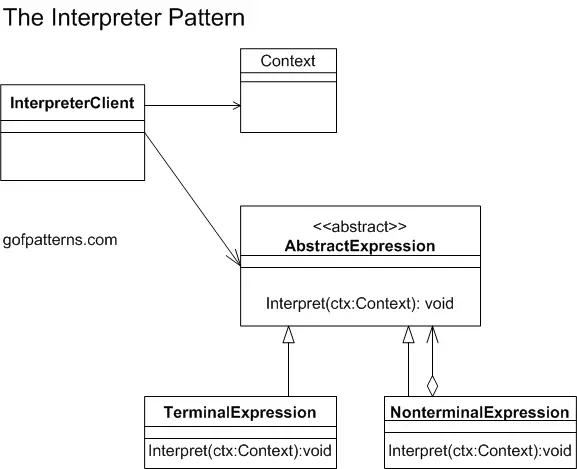The Interpreter Pattern: Analyzing Its Role and Function within the Behavioral Patterns Paradigm
In the vast landscape of design patterns, Behavioral Patterns command a distinctive position, primarily focusing on the interplay between objects and the patterns of communication between them. Amidst these, the Interpreter Pattern stands out, not necessarily due to its frequent use, but because of its specialized nature in interpreting domain-specific languages. This analytical exposition delves into the essence, mechanics, and broader implications of the Interpreter Pattern within the context of Behavioral Patterns.
The Interpreter Pattern is a nuanced member of the Behavioral Patterns family, uniquely addressing the challenges of domain-specific language interpretation. While its conceptual underpinnings are invaluable, its practical application is often circumscribed by its inherent limitations. Nevertheless, when judiciously applied within its intended scope, it offers a structured methodology to translate domain languages into tangible operations. As with all design patterns, the true measure of its efficacy lies not in its abstract design but in its contextual application.
- Contextual Placement: To understand the Interpreter Pattern, one must first recognize its unique placement within the Behavioral Patterns family. While most Behavioral Patterns (like Observer, Strategy, or Command) address general-purpose communication and responsibility delegation problems, the Interpreter Pattern specifically grapples with the interpretation of specific languages or expressions.
- Core Premise: The Interpreter Pattern provides a way to evaluate domain-specific language sentences or expressions for particular languages. It primarily offers representation and interpretation capabilities for grammar rules, enabling a mechanism to process defined sentences of the language.
- Structural Mechanics:
- Abstract Expression: This defines an interface or an abstract class that declares an interpret operation, which all concrete expressions must implement.
- Terminal and Nonterminal Expressions: Terminal expressions represent the leaf nodes in the abstract syntax tree and do not have further sub-expressions. Nonterminal expressions, conversely, are composite and may have multiple sub-expressions, embodying the grammar rules.
- Context: Often encapsulates global information, shared across the interpreter tree. It might hold state, variable bindings, or other relevant data.
- Client: Assembles the syntax tree and invokes the interpret operation.
- Analytical Implications:
- Specialized Use-Case: The Interpreter Pattern, by design, is tailored for specific, limited scenarios where the grammar of the domain-specific language is relatively simple and doesn't require expansive parsing techniques.
- Performance Concerns: Recursive traversal and interpretation can be computationally intensive, especially for complex expressions. Thus, while the pattern provides a structured approach, it might not be optimal for languages with extensive grammars.
- Maintainability: Introducing new grammar rules or modifying existing ones can necessitate substantial changes, challenging the principle of open-closed design.
- Comparative Analysis:
While Behavioral Patterns predominantly deal with object dynamics, the Interpreter Pattern's focus on language parsing makes it somewhat an outlier. Patterns like Command encapsulate a request as an object, and Strategy encapsulates algorithms, but Interpreter encapsulates the translation of a language's grammar into actionable operations. It bears resemblance to the Composite Pattern (a Structural Pattern) due to its hierarchical, tree-based structure, hinting at the pattern's interdisciplinary nature. - Modern Software Landscape: With the proliferation of domain-specific languages in various fields, from finance to bioinformatics, the foundational idea of the Interpreter Pattern is ever-relevant. However, industrial-strength language parsers often resort to more robust techniques, relegating the Interpreter Pattern to simpler, more contained use-cases.
The Interpreter Pattern is a nuanced member of the Behavioral Patterns family, uniquely addressing the challenges of domain-specific language interpretation. While its conceptual underpinnings are invaluable, its practical application is often circumscribed by its inherent limitations. Nevertheless, when judiciously applied within its intended scope, it offers a structured methodology to translate domain languages into tangible operations. As with all design patterns, the true measure of its efficacy lies not in its abstract design but in its contextual application.
The Interpreter pattern interprets a language to define a representation for its grammar along with an interpreter that uses the representation to interpret sentences in the language. The following diagram illustrates the Interpreter pattern.

Benefits of the Interpreter Pattern:
The following lists the benefits of using the Interpreter pattern:
- Easy to change and extend the grammar
- Implementing the grammar is easy
When to Use the Interpreter Pattern:
You should use the Interpreter pattern when:
- The grammar of the language is simple.
- Efficiency is not a critical concern.
Interpreter Pattern: Useful when the objective is to provide a client program or a user the ability to specify operations in a simple language. Helps in interpreting operations specified using a language, using its grammar. More suitable for languages with simple grammar.
Interpreter Pattern Java Code